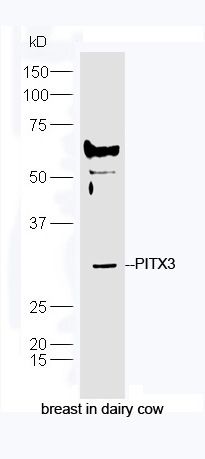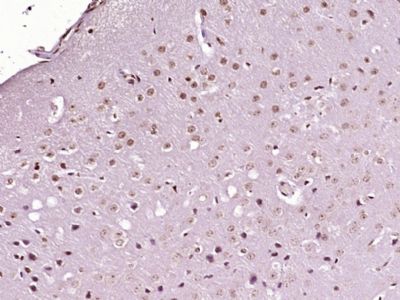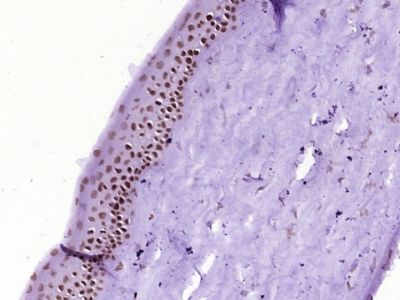产品中心
当前位置:首页>产品中心Anti-PITX3
货号: bs-2364R 基本售价: 1380.0 元 规格: 100ul
- 规格:100ul
- 价格:1380.00元
- 规格:200ul
- 价格:2200.00元
产品信息
- 产品编号
- bs-2364R
- 英文名称
- PITX3
- 中文名称
- 炎症因子3/穿透素抗体
- 别 名
- Homeobox protein PITX 3; Homeobox protein PITX3; MGC12766; Paired like homeodomain transcription factor 3; Paired-like homeodomain transcription factor 3; Pituitary homeobox 3; PITX 3; Pitx3; PITX3_HUMAN; PTX 3; PTX3.
- 规格价格
- 100ul/1380元购买 200ul/2200元购买 大包装/询价
- 说 明 书
- 100ul 200ul
- 研究领域
- 细胞生物 免疫学 染色质和核信号 神经生物学 表观遗传学
- 抗体来源
- Rabbit
- 克隆类型
- Polyclonal
- 交叉反应
- Human, Mouse, Rat, Chicken, Dog, Pig, Cow, Horse, Rabbit,
- 产品应用
- WB=1:500-2000 ELISA=1:500-1000 IHC-P=1:400-800 IHC-F=1:400-800 IF=1:100-500 (石蜡切片需做抗原修复)
not yet tested in other applications.
optimal dilutions/concentrations should be determined by the end user.
- 分 子 量
- 32kDa
- 细胞定位
- 细胞核
- 性 状
- Lyophilized or Liquid
- 浓 度
- 1mg/ml
- 免 疫 原
- KLH conjugated synthetic peptide derived from human PITX3:231-302/302
- 亚 型
- IgG
- 纯化方法
- affinity purified by Protein A
- 储 存 液
- 0.01M TBS(pH7.4) with 1% BSA, 0.03% Proclin300 and 50% Glycerol.
- 保存条件
- Store at -20 °C for one year. Avoid repeated freeze/thaw cycles. The lyophilized antibody is stable at room temperature for at least one month and for greater than a year when kept at -20°C. When reconstituted in sterile pH 7.4 0.01M PBS or diluent of antibody the antibody is stable for at least two weeks at 2-4 °C.
- PubMed
- PubMed
- 产品介绍
- background:
The transcription factor PITX3 is expressed selectively in the midbrain and regulates the differentiation and survival of dopaminergic neurons. Lack of this factor results in a degeneration similar to that seen in Parkinsons disease. PITX3 is also important in eye developement; mutations of the PITX3 gene have been associated with a familial form of cataracts.
Function:
Transcriptional regulator which is important for the differentiation and maintenance of meso-diencephalic dopaminergic (mdDA) neurons during development. In addition to its importance during development, it also has roles in the long-term survival and maintenance of the mdDA neurons. Activates NR4A2/NURR1-mediated transcription of genes such as SLC6A3, SLC18A2, TH and DRD2 which are essential for development of mdDA neurons. Acts by decreasing the interaction of NR4A2/NURR1 with the corepressor NCOR2/SMRT which acts through histone deacetylases (HDACs) to keep promoters of NR4A2/NURR1 target genes in a repressed deacetylated state. Essential for the normal lens development and differentiation. Plays a critical role in the maintenance of mitotic activity of lens epithelial cells, fiber cell differentiation and in the control of the temporal and spatial activation of fiber cell-specific crystallins. Positively regulates FOXE3 expression and negatively regulates PROX1 in the anterior lens epithelium, preventing activation of CDKN1B/P27Kip1 and CDKN1C/P57Kip2 and thus maintains lens epithelial cells in cell cycle.
Subunit:
Interacts with SFPQ.
Subcellular Location:
Nucleus.
Tissue Specificity:
Highly expressed in developing eye lens.
DISEASE:
Defects in PITX3 are a cause of cataract autosomal dominant (ADC) [MIM:604219]. Cataract is an opacification of the crystalline lens of the eye that frequently results in visual impairment or blindness. Opacities vary in morphology, are often confined to a portion of the lens, and may be static or progressive. In general, the more posteriorly located and dense an opacity, the greater the impact on visual function. Cataract is the most common treatable cause of visual disability in childhood.
Defects in PITX3 are a cause of anterior segment mesenchymal dysgenesis (ASMD) [MIM:107250]; also known as anterior segment ocular dysgenesis (ASOD). ASMD consists of a range of developmental defects in structures at the front of the eye, resulting from abnormal migration or differentiation of the neural crest derived mesenchymal cells that give rise to the cornea, iris, and other components of the anterior chamber during eye development. Mature anterior segment anomalies are associated with an increased risk of glaucoma and corneal opacity. Conditions falling within the phenotypic spectrum include aniridia, posterior embryotoxon, Axenfeld anomaly, Reiger anomaly/syndrome, Peters anomaly, and iridogoniodysgenesis.
Defects in PITX3 are the cause of cataract posterior polar type 4 (CTPP4) [MIM:610623]. A subcapsular opacity, usually disk-shaped, located at the back of the lens. It can have a marked effect on visual acuity. Some patients affected by cataract posterior polar type 4 can present a severe phenotype including microphthalmia and neurological dysfunction.
Similarity:
Belongs to the paired homeobox family. Bicoid subfamily.
Contains 1 homeobox DNA-binding domain.
SWISS:
O75364
Gene ID:
5309
Database links:Entrez Gene: 5309 Human
Entrez Gene: 18742 Mouse
Entrez Gene: 29609 Rat
Omim: 602669 Human
SwissProt: O75364 Human
SwissProt: Q5VZL2 Human
SwissProt: O35160 Mouse
SwissProt: P81062 Rat
Unigene: 137568 Human
Unigene: 6255 Mouse
Unigene: 22092 Rat
Important Note:
This product as supplied is intended for research use only, not for use in human, therapeutic or diagnostic applications.
PITX3是一种急性期反应蛋白,也是一种炎症标志物,在炎症级联反应中均起着重要作用,并参与了机械牵张刺激引起的炎症反应过程。
- 产品图片
 Sample: breast in dairy cow (Cow) Lysate at 40 ug
Sample: breast in dairy cow (Cow) Lysate at 40 ug
Primary: Anti-PITX3 (bs-2364R) at 1/300 dilution
Secondary: HRP conjugated Goat-Anti-rabbit IgG (bs-0295G-HRP) at 1/5000 dilution
Predicted band size: 32 kD
Observed band size: 32 kD Paraformaldehyde-fixed, paraffin embedded (Mouse brain); Antigen retrieval by boiling in sodium citrate buffer (pH6.0) for 15min; Block endogenous peroxidase by 3% hydrogen peroxide for 20 minutes; Blocking buffer (normal goat serum) at 37°C for 30min; Antibody incubation with (PITX3) Polyclonal Antibody, Unconjugated (bs-2364R) at 1:400 overnight at 4°C, followed by operating according to SP Kit(Rabbit) (sp-0023) instructionsand DAB staining.
Paraformaldehyde-fixed, paraffin embedded (Mouse brain); Antigen retrieval by boiling in sodium citrate buffer (pH6.0) for 15min; Block endogenous peroxidase by 3% hydrogen peroxide for 20 minutes; Blocking buffer (normal goat serum) at 37°C for 30min; Antibody incubation with (PITX3) Polyclonal Antibody, Unconjugated (bs-2364R) at 1:400 overnight at 4°C, followed by operating according to SP Kit(Rabbit) (sp-0023) instructionsand DAB staining. Paraformaldehyde-fixed, paraffin embedded (Rat eye); Antigen retrieval by boiling in sodium citrate buffer (pH6.0) for 15min; Block endogenous peroxidase by 3% hydrogen peroxide for 20 minutes; Blocking buffer (normal goat serum) at 37°C for 30min; Antibody incubation with (PITX3) Polyclonal Antibody, Unconjugated (bs-2364R) at 1:400 overnight at 4°C, followed by operating according to SP Kit(Rabbit) (sp-0023) instructionsand DAB staining.
Paraformaldehyde-fixed, paraffin embedded (Rat eye); Antigen retrieval by boiling in sodium citrate buffer (pH6.0) for 15min; Block endogenous peroxidase by 3% hydrogen peroxide for 20 minutes; Blocking buffer (normal goat serum) at 37°C for 30min; Antibody incubation with (PITX3) Polyclonal Antibody, Unconjugated (bs-2364R) at 1:400 overnight at 4°C, followed by operating according to SP Kit(Rabbit) (sp-0023) instructionsand DAB staining.

